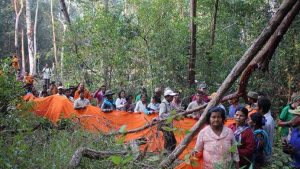
Several small caves were discovered last month near the famous Trirashmi Buddhist caves outside of the city of Nashik in the Indian state of Maharashtra. Situated on the opposite side of the mountain from the well-known and previously excavated caves at the site, these caves are much smaller site and may predate their larger counterparts by centuries. The smaller caves had been previously obscured by the rough terrain and thick vegetation.
Salim Patel, a staffer at the Archaeological Survey of India (ASI), stumbled across two of the caves on 22 May, during routine clearing of vegetation on the hill. He had been looking for a place to dump soil and vegetation that had been removed when he spotted an opening in the hillside.
“I went closer and removed the tree branches covering the cavity. I saw two cave-like structures that had been carved out of the rock. I immediately informed my seniors, including Shende sir, who were at the spot,” Patel said. “I was thrilled. This is the first time something like this has happened to me in 25 years of my service,” (The Indian Express)
Shende said that the ASI would document the caves and that, for now, the public was not allowed to visit the site, which lacks pathways and safety railings.
Atul Bhosekar, director of the Mumbai-based Trirashmi Research Institute of Buddhism, Indic Language, and Scripts, has studied the caves on the hill for nearly three decades. After a visit to the area, he noted: “These caves are on the opposite side of the current complex, and 70–80 feet above the existing complex. The caves have been carved out of a steep hill, and looking at the style of carving, it looks like these were monks’ dwellings, older than the current complex.” (The Indian Express)
Maitreyee Bhosekar, the daughter of Atul Bhosekar, who a Nashik-based archaeologist and is documenting the newly discovered caves, added: “Looking at the layout and architecture of these caves, it is possible that they were carved before the existing caves; however, their precise age can be ascertained only after proper study and comparison with the existing caves.” (The Indian Express)

Atul Bhosekar suggested that there may be further discoveries to be made when the area is more thoroughly surveyed. “There could be still 2-3 more caves in this area that are yet to be discovered,” he said. “The entire Trirashmi mountain has to be scanned in a proper way. There are two factors behind why these caves remained hidden for so long. The first documentation of the complex was done in 1823. At that time, there must [have been] a dense forest in that area. Now also, people visit the caves or directly go to the top of the mountain. There are caverns that remain hidden in the bushes and the trees from the human eye. The third cave which we discovered was very difficult to reach.” (Hindustan Times)
Bhosekar further suggested that a study of these caves may redefine the chronology of Buddhist caves in the region. “Whatever we could gather from archeological parameters, historical records, and a comparison with the nearby caves, such as Kanheri near Nashik, Karle-Bhaje near Pune, it appears that these newly discovered caves are in the rudimentary stage of building,” he said. “Our prima facie guess is that these three caves were built before the other caves. An extensive study and proper documentation have to be done for us to ascertain the accurate age of these caves.” (Hindustan Times)

The existing caves, known as the Buddhaleni Caves (leni is a Marathi word for caves), are believed to date to a period between the third century BCE and the third century CE, with additional sculptures added through the sixth century. They were built on Trirashmi Hill, approximately 915 meters above sea level. The known caves are dug from the north-facing side of the hill, largely protecting them from the Sun as well as rain and wind that typically move in from the southwest. Today, they represent a small center of tourism for Maharashtra and for existing and planned Buddhist circuit tourism. They are approximately 260 kilometers west by road from the better-known Ajanta Caves.
See more
In Nashik’s Buddhist caves complex, a chance new find (The Indian Express)
3 new caves in Nashik’s Pandav Leni complex; ASI to launch extensive survey (Hindustan Times)
Pandav Caves, Nashik District (Government of India)
Related news reports from Buddhistdoor Global
Lessons in Impermanence: Ajanta Caves Under Threat
Conservation of Shah Allah Ditta Caves in Pakistan Scheduled to Commence in March
Sri Lanka Archaeologists Race Against Time to Preserve Ancient Buddhist Monastery
K.J. Somaiya College, Mumbai, Launches Course on Buddhism for Engineering Students
Related features from Buddhistdoor Global
A Journey Through the Art of Compassion with Benoy K. Behl: The Ajanta Caves
Ajanta Relived: The Restorative Work of M. R. Pimpare
The Kanheri Caves, Mumbai: A Precious Monument to Buddhist Civilization
Ajanta – A Portrait of Faith
An Archaeological History of Indian Buddhism – Book Review
The Buddhist Understanding of Civilization












